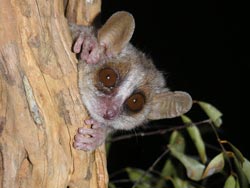Polyandry: An evolutionary puzzle

Wild adult grey mouse lemur (Microcebus murinus) in Kirindy Forest, Western Madagascar. Photo: E. Huchard / German Primate Center<br>
The fact that males want to reproduce with as many partners as possible can easily be explained in terms of evolutionary biology, since they thereby increase their chance of having large numbers of offspring.
Things look different for females; their number of offspring does not increase with the number of their sexual partners. Nevertheless, polyandry is widespread in the animal kingdom. Scientists from the German Primate Center in Göttingen investigated in a study with mouse lemurs (small primates from Madagascar) whether females mate with different males in order to avoid permanent sexual harassment. They found that the lemur females actively look for different partners rather than just giving in to the males’ pushing. (Proceedings of the Royal Society B).
The classical socioecological model in biology assumes that males want to mate with as many females as possible in order to pass on their genes to the next generation through a large number of offspring. Females, on the other hand, are more discriminating; they look for the best father for their offspring. Sex with changing partners mainly involves disadvantages for them, because they may catch sexually transmitted diseases or could be injured during the sexual act.
Why does polyandry nevertheless occur in the animal kingdom? One explanation could be that the females give in to the courting by males in order to avoid permanent sexual harassment. Elise Huchard and her team at the German Primate Center (DPZ) in Göttingen tested this hypothesis experimentally. As objects of study, they chose gray mouse lemurs, small Malagasy primates that weigh only about 60 grams, because males and females of this species are almost the same size. The scientists were able to manipulate the size of females by an increase or reduction of the food supply in such a way that in one experimental approach the females were larger than males and smaller in the other group. The scientists expected that the larger females would mate with fewer males, because they would be better able to defend themselves against undesired overtures. But things turned out very differently: the large females had considerably more sexual partners than the little ones. “The lemur females actively look for changing sexual partners, so this must be advantageous for them“ said Elise Huchard from the German Primate Center.
The scientists also found that the large number of sexual acts causes energetic costs to both males and females. “We therefore assume that polyandry is a flexible strategy which leads to moderate advantages for the female mouse lemurs”, Huchard states. For weaker females it therefore seems to be better to save their strength and to be satisfied with few partners, whereas strong females have an evolutionary advantage if they mate with several males.
Original Publication
Huchard, E., Canale, C., Le Gros, C., Perret, M., Henry, P.-Y., Kappeler, P. (2011). Convenience polyandry or convenience polygyny? Costly sex under female control in a promiscuous primate. Proceedings of the Royal Society B
Contact
Dr. Elise Huchard
Phone: +49 551 3851-470
email: ehuchard@dpz.eu
Dr. Susanne Diederich (DPZ Press Office)
Phone: +49 551 3851-359
email: sdiederich@dpz.eu
The German Primate Center (DPZ) – Leibniz Institute for Primate Research in Göttingen (www.dpz.eu) conducts biological and biomedical research on and with primates in the areas of organismic biology, infection research and neurosciences. In addition, it maintains four field sites abroad and is competence and reference center for all issues relating to primate research. The DPZ is one of the 87 research and infrastructure institutes within the Leibniz Community (http://www.wgl.de/).
Media Contact
All latest news from the category: Life Sciences and Chemistry
Articles and reports from the Life Sciences and chemistry area deal with applied and basic research into modern biology, chemistry and human medicine.
Valuable information can be found on a range of life sciences fields including bacteriology, biochemistry, bionics, bioinformatics, biophysics, biotechnology, genetics, geobotany, human biology, marine biology, microbiology, molecular biology, cellular biology, zoology, bioinorganic chemistry, microchemistry and environmental chemistry.
Newest articles

Superradiant atoms could push the boundaries of how precisely time can be measured
Superradiant atoms can help us measure time more precisely than ever. In a new study, researchers from the University of Copenhagen present a new method for measuring the time interval,…

Ion thermoelectric conversion devices for near room temperature
The electrode sheet of the thermoelectric device consists of ionic hydrogel, which is sandwiched between the electrodes to form, and the Prussian blue on the electrode undergoes a redox reaction…

Zap Energy achieves 37-million-degree temperatures in a compact device
New publication reports record electron temperatures for a small-scale, sheared-flow-stabilized Z-pinch fusion device. In the nine decades since humans first produced fusion reactions, only a few fusion technologies have demonstrated…





















